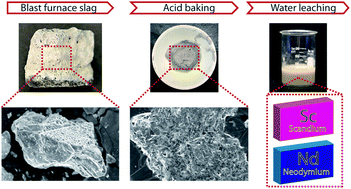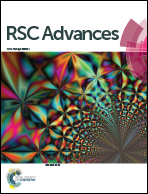Recovery of scandium and neodymium from blast furnace slag using acid baking–water leaching†
Abstract
The current study puts the emphasis on developing a pyro-hydrometallurgical process, called acid baking–water leaching, to recover scandium and neodymium from blast furnace slag produced by the ironmaking industry. In this process, the feed is mixed with concentrated sulfuric acid, digested at 200–400 °C, and leached in water at ambient conditions. This process offers several advantages including less acidic waste generation and rapid kinetics. With fundamental investigations into the digestion mechanism, acid to slag mass ratio and baking temperature are determined to have the most significant positive and negative impacts, respectively. At low acid to slag ratio, the silicate bearing phases in the feed do not digest, resulting in low extraction. At 200 °C baking temperature, a hydrated aluminum sulfate ((Al(H2O)6)2(SO4)3(H2O)4.4) phase with weak hydrogen bonds is formed that leaches in water rapidly (<10 min); while at 400 °C, Al2(SO4)3 with strong ionic bonds is formed that leaches at slower kinetics (>4 h). Fundamental investigations into the water leaching process indicate that the diffusion of water through the firm solid product (ash layer) is the rate determining step. We expect the results of this study would help enable valorization of industrial byproducts, in particular ironmaking slag.



 Please wait while we load your content...
Please wait while we load your content...